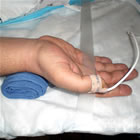
|
As the Task Force Chairperson, Professor Marco Roffi of Switzerland, stated: "New data shows that the radial approach is superior to the femoral not only in terms of vascular complications and major bleeding events but also in reducing all-cause mortality. It is recommended that centres treating ACS patients implement a transition from transfemoral to transradial access. However, proficiency in the femoral approach should be maintained, as this access is indispensable in a variety of procedures, including intra-aortic balloon counterpulsation implantation, structural heart disease interventions, and peripheral revascularization procedures." This revolutionary, or perhaps evolutionary, recommendation comes 23 years after the first coronary stents were placed using the radial artery in the wrist. These pioneering procedures were performed by Dr. Ferdinand Kiemeneij in The Netherlands in 1992. (Read our exclusive interview with Dr. Kiemeneij.) Although the adoption of the radial artery approach has taken almost a quarter of a century, today the majority of PCI procedures in the UK and elsewhere are done via the wrist. In the United States, the adoption rate is significantly lower, perhaps less than 20%, but has been increasing rapidly in use in the past decade. A number of U.S. interventional cardiologists have labeled themselves as "Radial First" operators: where the transradial approach is the default. The ESC Guidelines state that the recommendation is given the rating of 1a, based on the results of both the RIVAL study, presented in 2011, and the MATRIX study, presented at the 2015 at the American College of Cardiology Annual Symposium in March. One of the problems in treating ACS patients via the femoral (groin) approach is the prevalence of bleeding complications due to the access site. An ACS patient requires significant anticoagulation to prevent the build-up of thrombus, a build-up that may result in a heart attack. But paradoxically this anticoagulation regimen increases the potential for bleeding complications. With the radial approach, using the wrist artery, the bleeding risks are vastly reduced, almost to zero, giving radial a significant advantage over the femoral approach. Although much of Europe, Japan, India and other countries have already adopted the radial approach, today's change in the guidelines will give added momentum to the "radial first" movement in which the radial approach is considered the default. In fact, the authors of the MATRIX study (Valgimigli et al) stated back in March that their results should prompt a re-evaluation of clinical guidelines and that the wrist, currently used in a minority of cases in the United States, should be the preferred approach for most catheter-based heart procedures. The European Society of Cardiology has now adopted this approach for ACS patients. It remains to be seen if the U.S. will follow. About The Radial Access Center on Angioplasty.Org For interventional cardiologists and cath lab staff, Angioplasty.Org also maintains a listing of upcoming training courses in the transradial approach. For patients, there is a unique "Radial Hospital Locator" that lists over 300 centers practicing radial angiography. As Dr. Howard Cohen says of the wrist technique, "Patients really prefer it. 95% of people who've had it both ways would say 'I'm coming back to you, Dr. Cohen because I like this transradial a lot better than the other way!' Reported by Burt Cohen, August 29, 2015 |
